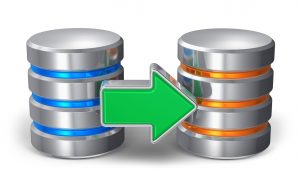Enterprise DR is like having insurance for your cell phone.
Thank you, Kevin Kornblith, for this analogy.
Some people can lose a phone, and if they take a week to get a new one, it’s no big deal. Others might drop a phone in the sink and be okay if it takes a couple hours to drive to a store to pick up a new one. Then, there are people who, when they hear that dreaded cruuuunch of a broken phone, they need someone to slap a new phone in their hand immediately. This is how we see disaster recovery solutions today.
 You’ve got storage based snapshots, which are often performance impacting and confined to finite windows to limit their collateral damage. As a result, they don’t run often; and it’s very common to have a snapshot once every 24 hours. Although cost effective, you expose yourself to losing 23:59 hours of data. In a real disaster and failover, the environment would still need to be pieced back together.
You’ve got storage based snapshots, which are often performance impacting and confined to finite windows to limit their collateral damage. As a result, they don’t run often; and it’s very common to have a snapshot once every 24 hours. Although cost effective, you expose yourself to losing 23:59 hours of data. In a real disaster and failover, the environment would still need to be pieced back together.
Business Continuity systems, like Veeam, do an excellent job at protecting data, and their recovery points continue to shrink. They’re now down to a 15-minute Recovery Point, which is excellent for their continuity role. However, if you’re in an industry with a high cost of downtime, you might still need something better. Active-Active systems are an option – but wow, you’re going to pay for it.
For a fraction of the cost of active-active, you should use Zerto. Zerto is hardware and hypervisor agnostic with Recovery Points of 5 seconds and Recovery Times of 10 minutes. It also has a couple of bonuses that can be used while you wait and hope to never need a true DR solution.
Zerto can be used to migrate VMs. Since it’s hardware and hypervisor agnostic, you can migrate from AWS to Azure to any storage array. Its non-disruptive DR testing is fantastic, and you can spin off nearly real-time environments for test dev. Plus, it’s a great tool for cryptolocker or ransomware mitigation – just “roll-back” to the second before an attack.
Enterprise DR is like having insurance for your cell phone.
Thank you, Kevin Kornblith, for this analogy.
Some people can lose a phone, and if they take a week to get a new one, it’s no big deal. Others might drop a phone in the sink and be okay if it takes a couple hours to drive to a store to pick up a new one. Then, there are people who, when they hear that dreaded cruuuunch of a broken phone, they need someone to slap a new phone in their hand immediately. This is how we see disaster recovery solutions today.
 You’ve got storage based snapshots, which are often performance impacting and confined to finite windows to limit their collateral damage. As a result, they don’t run often; and it’s very common to have a snapshot once every 24 hours. Although cost effective, you expose yourself to losing 23:59 hours of data. In a real disaster and failover, the environment would still need to be pieced back together.
You’ve got storage based snapshots, which are often performance impacting and confined to finite windows to limit their collateral damage. As a result, they don’t run often; and it’s very common to have a snapshot once every 24 hours. Although cost effective, you expose yourself to losing 23:59 hours of data. In a real disaster and failover, the environment would still need to be pieced back together.
Business Continuity systems, like Veeam, do an excellent job at protecting data, and their recovery points continue to shrink. They’re now down to a 15-minute Recovery Point, which is excellent for their continuity role. However, if you’re in an industry with a high cost of downtime, you might still need something better. Active-Active systems are an option – but wow, you’re going to pay for it.
For a fraction of the cost of active-active, you should use Zerto. Zerto is hardware and hypervisor agnostic with Recovery Points of 5 seconds and Recovery Times of 10 minutes. It also has a couple of bonuses that can be used while you wait and hope to never need a true DR solution.
Zerto can be used to migrate VMs. Since it’s hardware and hypervisor agnostic, you can migrate from AWS to Azure to any storage array. Its non-disruptive DR testing is fantastic, and you can spin off nearly real-time environments for test dev. Plus, it’s a great tool for cryptolocker or ransomware mitigation – just “roll-back” to the second before an attack.
Have you heard about Zerto? More importantly, are you using Zerto?
Zerto is taking the IT world by storm, providing a simple, yet fully functional, replication and data protection Disaster Recovery (DR) solution.
What makes Zerto so unique is its simplicity.
Zerto Virtual Replication 4.5 was recently released, and this blog provides a description of some of the additional functionality provided in 4.5. (If you would like to learn more about Zerto aside from the newest features released in 4.5, please reach out to Zunesis.)
Zerto Virtual Replication 4.5 builds upon their always-on replication, with no snapshots, replication and orchestration capabilities by adding granular recovery. Now, a single file or folder can be recovered from the journal, improving the average time to recovery for files, folders, VMs, applications, and sites.

Many other improvements were made to simplify disaster recovery operations, further reducing ongoing management and maintenance, and to automate more DR operations to ensure consistency and repeatability.
File and Folder Recovery from the Journal – What is the most common disaster that administrators must recover? It isn’t natural disasters or site outages; it is actually lost or accidently deleted files or folders. In release 4.5, Zerto solves this most frequent disaster problem by adding the ability to recover a single file or folder from up to 14 days in the past, from increments in seconds from the journal with just a few mouse clicks. With other solutions, the file is pulled from nightly infrequent backups, which could result in data loss and missed user expectations.
Improved Role-Based Access Control – The security of your business continuity and disaster recovery plan is of the utmost importance. It is imperative that those who are making changes or updates fully understand the impact of these changes in the event that recovery is needed. In addition to the already robust permissions available from Zerto Virtual Replication, these have been added.
View Only – The ability to log into Zerto Virtual Replication and view the settings and configurations of the BC/DR processes. This permission level does not allow for changes to be made.
Manage Workload Protection – The ability to modify virtual protection group (VPG) settings and update BC/DR plans and processes.
Recover and Migrate Workloads – The ability to actually execute the BC/DR or migration plan. Workloads will move according to the execution plan.

With 4.5, Zerto introduced new APIs to further automate VPG creation, protecting VMs and simplifying BC/DR operations:
- Simplify management with the ability to upgrade, install, uninstall, and configure Zerto Virtual Replication Appliances
- Effectively monitor alerts with all the active alerts provided with the ability to dismiss/retain alerts
- Fully automate the creation and editing of VPGs including VMs, networks, volumes, and NIC configuration to reduce install and ongoing maintenance
- Respond to changing business requirements with the ability to add and remove VMs from or to a VPG
- Increase storage efficiency with compression on the journal
- Extend the history of an application with less storage used.
In summary, Zerto Virtual Replication 4.5 ensures the continuous protection of applications, VMs, folders, and files. This increased granularity gives organizations unprecedented control over recovery operations. New APIs and role-based controls ensure the right commands are accessed and executed, further increasing control of critical IT operations.
To learn more about Zerto or to see a technical demonstration, please contact Zunesis at info@zunesis.com.

